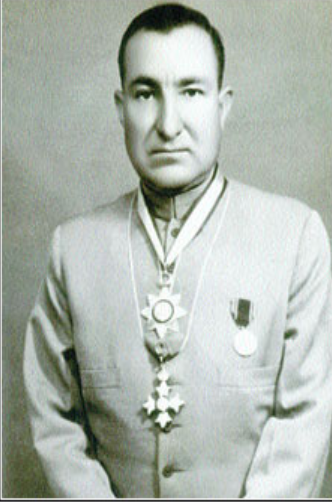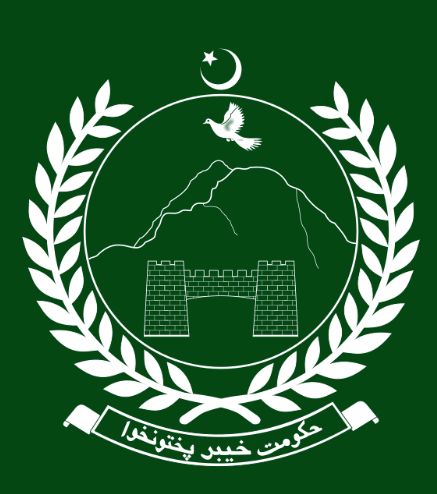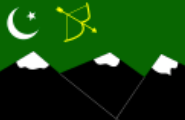I suspect (and cannot prove yet) that the N represents "Nagar." Here are the Indian princely hereditary states before Indian/Pak independence beginning with an "N,"
Nabha in PEPSU - Hereditary salute of 13 guns (15-guns local)
Nagar Pakistani Frontier State
Nagod - Hereditary salute of 9 guns = Nagodh in Madhya Pradesh
Nagpur in Madhya Pradesh- Political Pensioner
Nahara
Naigawan Ribai
Nalagarh in PEPSU
Nalagarh in Himachal Pradesh
Nalia
Nandgaon in Madhya Pradesh
Narsingarh in Madhya Pradesh - Hereditary salute of 11 guns
Narsinghpur in Orissa
Narukot
Narwar
Nashipur
Naswadi
Naugaon
Naulana
Navagarh
Nawanagar in Saurashtra - Hereditary salute of 13 guns (15-guns local)
Nayagarh in Orissa
Nilgiri in Orissa
Nilvala
Nimkhera
Nobo Sohoh
Noghanvadar
Nongklao
Nongspung
Nongstoin
I suspect the coat of arms belongs to Nagar Frontier State located in the area between Gilgit and Hunza. That area was sensitive for the Brits because of its proximity to China and Russia and its Nizam was cultivated by the Sirkar (British Raj).
https://en.wikipedia.org/wiki/Nagar_(princely_state)
"Nagar was another small valley state to the north of Kashmir and shared the language and culture of Hunza. In 1931 it had a population of 13,672, much the same as that of Hunza. On 18 November 1947 its ruler, Shaukat Ali Khan (1909–2003) joined his neighbour in acceding to Pakistan."
Here is its location - you guys have to read "Where Three Empires Meet" to understand the relationship between Kashmir, Chitral and the Brits in this area. Chitral to this day is very closely watch/controlled by the imperial successors to the Brits - the Pakistan government.

I cannot find a published coat of arms for Nagar - but if a Purdy made it's way to to that area...all 13,000 inhabitants...most of them Shi'a by the way...there is no doubt that it went to Mir Shaukat Ali Khan the Nizam of Nagar. He was educated, wealthy, and very close to Mohd Ali Jinna, founder of Pakistan. He was born in 1917 and died in 2003 and was utterly committed to the idea of "Pakistan." The privileges of the Nizam of Nagar and all the remaining princely states in Pakistan were absorbed by the Pakistan State in 1971.

I can't find a family crest or a crest for Nagar. But, as an example here is the crest of the British era Northwest Frontier Province (NWFP) when it was separated from Punjab about 1901:

And here was the flag of Hunza:

By the way, most Muslims in the area do not have "family names." i.e a baby is given a name...say "Ismail." a religious name is added before it...say "Mohammed." and a tribal, location, artisanal name after it..."Durrani." (the guy from the Durrani tribes) or "Rocketi" (rocket man) or "Dollari" (the man with the $ money) or "Kabuli" (they guy from Kabul). And they'll be known by other monikers as well... So unless there is a Persian connection (Zoroastrian origin and a long time tradition of family names) or modern day Pakistani in some contexts (also adopting family names) you can't tell the family by the name unless they add "son of" and "grandson of" or unless there's a title in the mix.
Not having a family name has obvious problems for the organization of a state. One of the first things Ataturk in Turkey did was to require the Turks to take family names. In Afghanistan, the Communists did the same thing but forbade people from taking tribal or geographic last names. So if an Afghan has a family name he's of Persian (Tadjik) origin or is a leftist.
Abdul is sometimes added to their names. This is equivalent tothe Semitic "Abd al" (son of). For the Indo-European languages of Persia, Afghanistan, Pakistan, India etc..they had to add 5 vowels to make the arabic alphabet comprehensible..(Semetic languages have minimal vowels; "N nglsh ths s jst pssbl" ... but you can see the problem of trying to adapt a Semetic alphabet to a different language group. So in Persia-Afghanistan-Pakistan - it's "Abdul" (with the vowel) not the Arabic "Abd al".